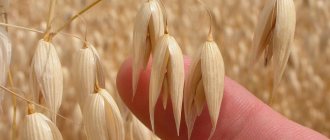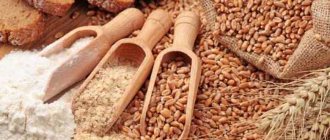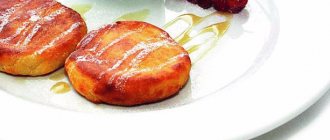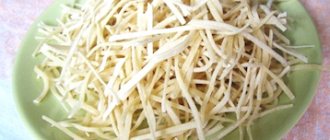Which bran is the most useful?
All types of seedings are concentrated sources of fiber, minerals and vitamins and have different effects. Their main benefit is a complex of essential substances that support health. They are rich in potassium, magnesium, iron, phosphorus, zinc, manganese, selenium, copper. Vitamins in bran from the group B1-B6, E, K, A. For preventive purposes, it is useful to alternate the use of different types.
Oatmeal
Oat bran is a real source of plant molecules and vitamin E; they help control blood pressure and reduce inflammation. Low calorie content, a godsend for those who want to lose weight. Oats are rich in beta-glucans (cholesterol-lowering polysaccharides) and do not contain gluten, which is bad for digestion.
Wheat
Dietary fiber makes the product beneficial for the stomach and intestines - they eliminate constipation and promote the elimination of toxins. Wheat seedings should be consumed 60 g daily - this will provide the daily intake of selenium, the deficiency of which leads to a decrease in immunity. Bran is rich in potassium and magnesium, which are necessary for normal heart function.
Rye
Rye is rich in Omega-3 and Omega-6 fatty acids, they support the immune system, the normal functioning of blood vessels and the brain, and reduce the level of bad cholesterol. Iodine in rye bran is well absorbed, helps the thyroid gland, and protects the body from harmful environmental influences.
Rice
This bran normalizes metabolism, which helps reduce weight. Acting like a brush, seedings absorb and remove harmful toxins, cleansing the intestines, and stimulate the reproduction of healthy microflora. A high level of calcium in the brown shell can reduce the manifestations of allergies and prevent the occurrence of skin diseases. Rice polysaccharides help maintain normal blood glucose levels and are recommended for diabetics.
Buckwheat
Buckwheat does not contain gluten; it and grains from cereals are consumed by people with gluten intolerance, which causes gastrointestinal disorders, bloating and diarrhea. The chemical composition helps normalize blood pressure, prevents cancer, reduces cholesterol and appetite, which helps get rid of extra pounds. A high percentage of iron increases hemoglobin.
Harm of bran to health and contraindications
Exceeding the daily intake of bran can cause side effects and harm human health. It is contraindicated to use any of the varieties of bran during exacerbation of the following diseases:
- gastritis;
- stomach ulcer;
- enteritis.
After the exacerbation passes, you can return bran to the diet in the amount of 1 teaspoon. In addition, it is strictly forbidden to eat the product if you are allergic to grains.
Systematic abuse of the product will lead to exacerbation of gastrointestinal diseases, flatulence, indigestion, and hypovitaminosis.
You can increase the daily dose of bran only on the recommendation of a nutritionist, and it is recommended to do this gradually.
© nolonely — stock.adobe.com
The benefits of bran for the human body
A large amount of dietary fiber helps fight many diseases. It is useful to use them to cleanse the intestines and use them in diets for weight loss. Seeds remove toxins, have a calming effect, and improve skin condition. The vitamins and minerals contained increase the beneficial properties of bran.
Nutritional and energy value
The combination of nutrients, fiber, and caloric content of seedings depends on the grain crop. Although their energy value is high, bran passes through the body in transit without increasing blood sugar. This means that insulin will not be released, and extra centimeters will not be deposited on the waist.
100 g of product contains:
| View | kcal | Proteins, g | Carbohydrates, g | Fiber, g | Fats, g |
| oat | 240 | 17,3 | 50 | 15 | 7 |
| wheat | 180 | 14,7 | 20,6 | 43 | 4,1 |
| rice | 315 | 21 | 30 | 21 | 12 |
| rye | 220 | 11 | 32 | 17 | 3 |
| buckwheat | 340 | 14 | 65 | 12 | 4,5 |
High antioxidant content
Different types of bran contain powerful antioxidants (just a small list):
- gamma-oryzanol – rejuvenates the body;
- squalene – weakens the growth of cancer cells, prolongs life, copes with skin diseases;
- ferulic acid – rejuvenates, protects skin from the sun and wrinkles, increases the bioavailability of vitamin E.
- avenatramide – protects blood vessels.
Blood Sugar Control
Beta-glucan increases the viscosity of food, soluble fiber, and slows down the digestion process and absorption of carbohydrates. After eating, there is no release of sugar into the blood; slow digestion does not lead to a sharp decline. For insulin-dependent people with type 2 diabetes, a major benefit of oat bran is glucose control. The slow breakdown of starch and the ability to influence the glycemic index of other foods in the intestines makes this supplement irreplaceable.
Reducing the risk of colorectal cancer
Grain bran has the ability to accumulate moisture 5 times heavier than its own weight. They absorb toxins, cholesterol, poisonous salts of heavy metals that cause cancer, and bring them out. The action of fibers in combination with proteins produces butyric acid, which can stop the growth of cancer cells.
Types of bran
Depending on the processed cereal, they are divided into the following types:
- buckwheat - husks from buckwheat;
- rice - the shells of rice grains;
- barley - the outer shell of barley;
- oat - the shell of oats;
- wheat - husks from wheat grains;
- rye - a product of rye processing.
They are also divided into large and small depending on the degree of grinding.
Important! The most valuable and beneficial for health are oat bran.
Why do you need to eat bran?
The crushed grain shell, thanks to its rich composition and coarse fiber, helps with many diseases: obesity, cholecystitis, atherosclerosis. Reducing the level of bad cholesterol will protect against stroke, removing toxins will normalize metabolism and increase immunity.
For weight loss
Dietary fiber tends to swell in the stomach and intestines, maintaining a feeling of fullness for a long time. Soluble fiber reduces the level of ghrelin, a hormone that stimulates appetite, which largely determines the amount of food needed to satiate. The high nutritional value and low calorie content of the product is suitable for dietary nutrition - weight will be reduced, and the body will receive the necessary vitamins and minerals.
For digestion and gallbladder
Wheat bran is an optimal remedy for combating constipation. They improve food digestion and normalize pancreatic function. Oat and buckwheat seedings have a beneficial effect on the liver - beta-glucans expel bile and improve the functioning of the gallbladder. Bran fatty acids nourish intestinal cells, reducing inflammation and relieving pain.
For the heart and blood vessels
The main factors for the normal functioning of the circulatory system are proper food and a healthy lifestyle. The formation of cholesterol plaques is the scourge of our century. Heart attack and stroke can be avoided by controlling the level of LDL (bad cholesterol) in the blood. Bran beta-glucans lower blood pressure, reduce the risk of plaque formation in blood vessels, thereby reducing the risk of heart disease.
The use of bran in folk medicine
Traditional medicine, like traditional medicine, often uses bran-based recipes.
- If you have a weak immune system, it is recommended to take them with liquid honey: 1 tablespoon of the shells should be mixed with honey to form a paste and eaten at one time.
- Bran is also beneficial for hair. With regular use of this product in combination with milk, after a month your hair will become silkier and more vibrant.
We recommend reading: Benefits of beans, properties and contraindications
How to use it correctly
You need to start taking bran with 1-2 teaspoons per day, gradually increasing the volume. For preventive purposes, it is recommended to eat bran for two weeks, then a break of 14 days. To remove toxins and cleanse the intestines, you can eat dry bran with water, or add it to dishes, dividing the daily intake into several times.
For weight loss, daily intake of bran is useful, as advised by the famous French doctor Pierre Dukan. A popular diet recommends eating a tablespoon of seeds with a mandatory consumption of at least 1.5 liters of water daily.
Kefir or yoghurt with bran
Grain grinds have no taste or smell. It is useful to use them with fermented milk products and smoothies. Along with cleansing, the intestines are saturated with probiotics, which has a positive effect on digestion. Simply mix the measured amount of bran with kefir or your favorite yogurt.
Porridge with milk or water
For the dietary dish you will need:
- 200 grams of water or milk;
- 2 tbsp. tablespoons of bran (wheat and rye bran take longer to cook);
- salt to taste;
- Honey, berries, spices.
Add salt to the boiling liquid, add bran, bring to a boil, cook over low heat for 5-7 minutes, stirring. Remove, cover with a lid and let stand for a while. Pour honey over the prepared porridge, add berries or aromatic spices.
Ready-made bran products
The retail chain sells baked goods containing bran. The amount of sifting in bread and baked goods is not large; it is impossible to accurately control what else is contained in store-bought products. In order for the body to receive the required amount of nutrients, you will have to eat a lot of bread, and this does not contribute to a healthy diet and weight loss.
Ready-made fermented milk products with the addition of bran will bring more benefits to the body than baked goods. Their disadvantage is that they contain sugar, which will harm the pancreas. The amount of dietary fiber is indicated on the packaging, it is possible to count, but the final choice of products is yours.
How to select and store bran?
In absolutely any supermarket in the “Diet food” section you can easily find and choose the best option for this product.
Different pricing policies and detailed descriptions on the packaging will help satisfy every customer.
There is no difference between them; even a low-cost product fully complies with all standard requirements.
To attract buyers, some companies use flavoring additives, flavor enhancers, gluten, and flour, but the benefits of bran from such a product disappear.
It is best to give preference to options without impurities and additives.
It is important to know that this product is odorless and tasteless, completely amorphous. Having opened the package, make sure there are no signs of mold, no bitter taste; a gray-brown color is considered the norm.
If the product is of high quality, then it should be stored in a glass jar with a tight-fitting lid, in a dark, cool place.
Bran during breastfeeding
Doctors recommend continuing to consume the dry product during breastfeeding if the woman ate it throughout her pregnancy. However, if this is a new product in the diet, you need to start consuming it with a small amount. New components entering the body pass through milk to the baby. Because of this, it is necessary to carefully introduce new foods into the diet and, if negative changes occur, stop eating them. The first dose should not exceed one teaspoon. Gradually this amount can be increased to 30 grams.
Summarize
- Wheat bran is highly nutritious and an excellent source of fiber.
- This may benefit your digestive system and heart health, and even reduce your risk of breast and colon cancer.
- However, they are not suitable for people with gluten or fructan intolerance, and their phytic acid content may interfere with the absorption of certain minerals.
- For most people, wheat bran is a safe, easy and nutritious addition to baked goods, smoothies and yogurt.
Tags: Bran, Wheat
- Related Posts
- Pearl barley: benefits and harm to the human body
- What is the difference between bleached and unbleached flour?
- Couscous: what is it, benefits and harms
« Previous entry
Wheat bran in cosmetology
The natural product is in demand in cosmetology. It is the main ingredient in many masks that are designed to restore damaged structure of hair, nails, and skin.
For hair
A remedy made from bran (5 tbsp) and homemade kefir (150 ml) will help cope with increased fat content. The drink should be taken at room temperature. After combining the ingredients, leave them for 4 hours. During this time, the dense shell of the wheat grains will be filled with moisture, and the consistency will become more uniform.
The mask is applied for half an hour. Distribute the mixture along the entire length of the curls. After completing the procedure, you need to cleanse your hair with warm water (not hot!). To normalize the water-lipid balance, treatments should be repeated 2 times a week. within 1 month.
For face
It’s easy to make a nourishing mask that well restores subcutaneous processes using wheat bran. To do this, a finely ground product (2 tbsp) is combined with warm full-fat milk (50 ml). To enhance the cosmetic effect, it is recommended to add peach oil (2 tsp) to the mixture. The resulting product is allowed to brew for about 2 hours. After this, the composition is ready for application to the skin of the face. Treatment can be carried out in the décolleté area and on the neck. After 20 minutes, the remaining mixture is removed with warm water. It is better to complete this procedure by wiping with ice cubes.
The mask moisturizes and nourishes the skin, regulates the production of sebaceous secretion. Coarse fiber cleanses pores. An anti-inflammatory effect is also noted. The procedure must be repeated daily for 5-7 days.
Leaving the bran mixture on the skin of the face for more than 20 minutes is prohibited. The upper layers of the epidermis can be damaged.











